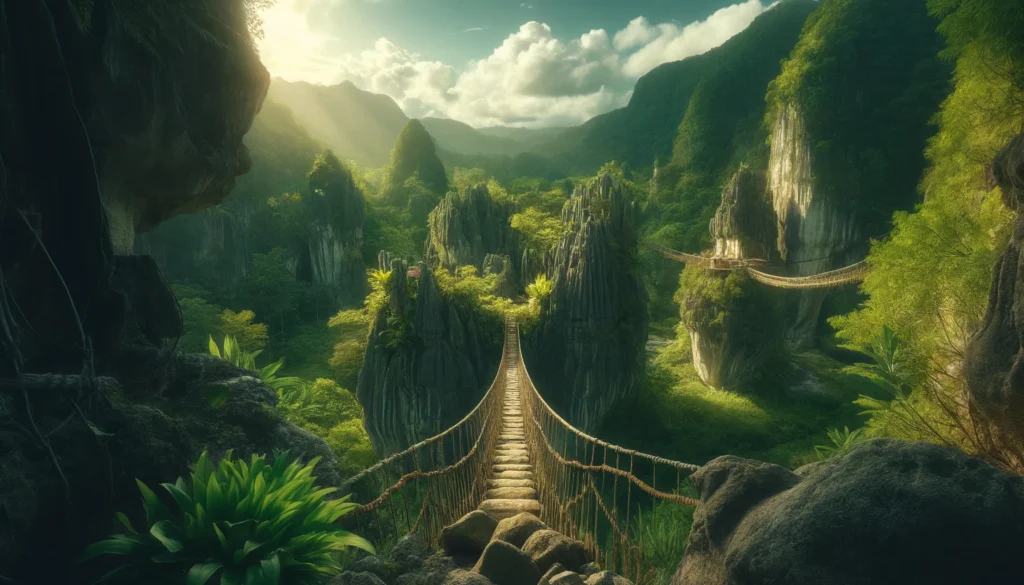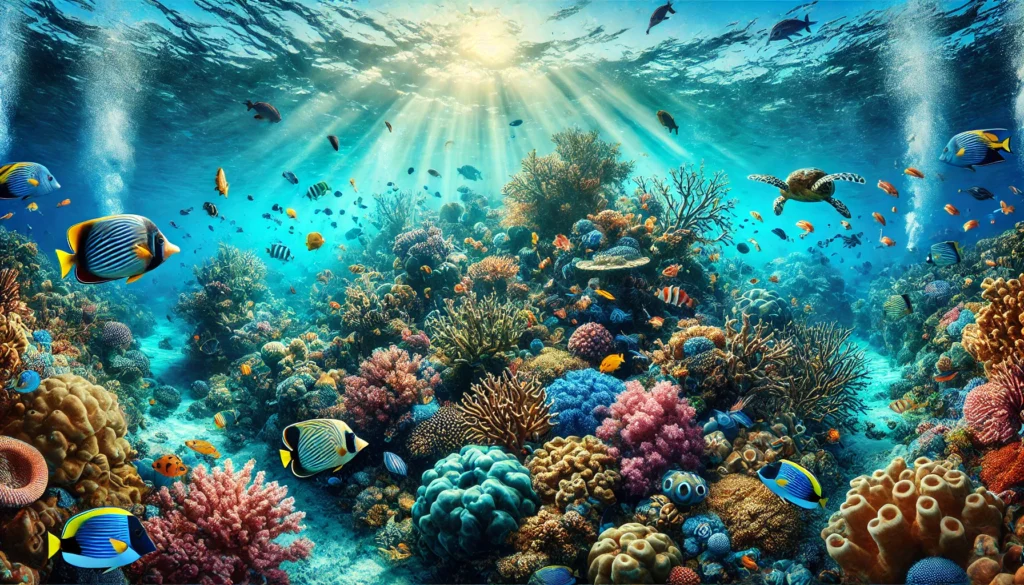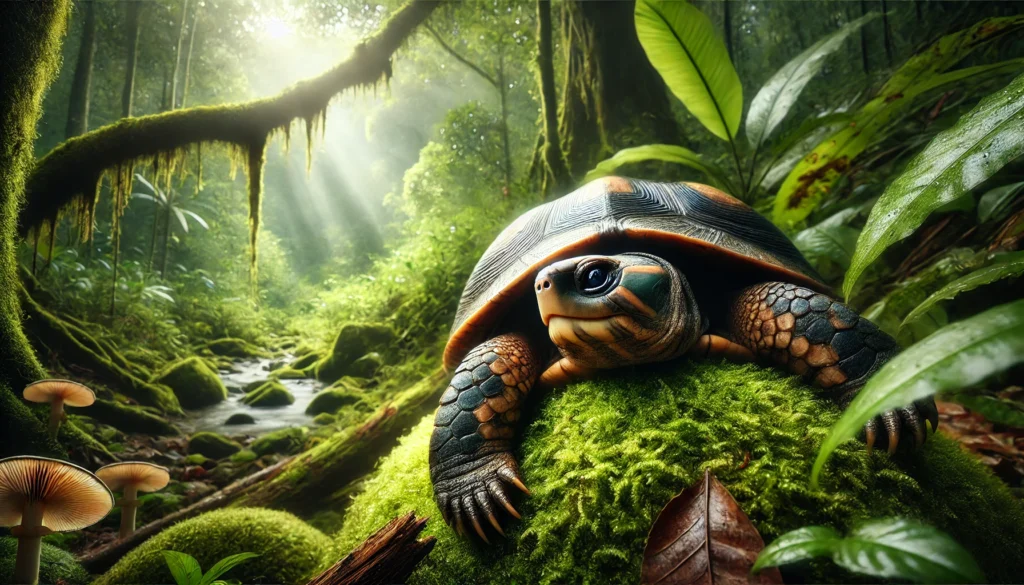Picture this: you’re teetering on a giant spider web made of steel cables, suspended high above a lush tropical forest. Below you, limestone formations jut out like nature’s own skyscrapers, while exotic birds serenade you with their melodious tunes. No, this isn’t a scene from the latest Indiana Jones movie or a fever dream after eating too much durian. Welcome to Masungi Georeserve, folks – where Mother Nature throws a party and everyone’s invited!
Nestled in the Sierra Madre mountain range of Rizal, Philippines, Masungi Georeserve is not your average conservation project. It’s a 2,000-hectare slice of paradise that’s been turning heads and dropping jaws since it opened to the public in 2015. But don’t let the stunning views fool you – this place is serious business when it comes to environmental protection and sustainable tourism.
In this blog post, we’re going to take a deep dive into the wonders of Masungi Georeserve. We’ll explore its unique approach to conservation, the challenges it faces, and why you should add it to your bucket list pronto. So strap on your virtual hiking boots, grab a imaginary water bottle, and let’s embark on this wild adventure together!
The Birth of Masungi: A Rocky Start (Pun Intended)
From Quarry to Quixotic Quest
Once upon a time, in a land not so far away, the area now known as Masungi Georeserve was facing a grim future. Illegal loggers were having a field day, treating the forest like an all-you-can-chop buffet. Quarrying operations were eyeing the limestone formations like they were giant cheese wheels ripe for the slicing. It was a dark time for the local ecosystem, and things were looking bleaker than a goth kid’s wardrobe.
But then, in 1996, a glimmer of hope appeared on the horizon. The Philippines Department of Environment and Natural Resources (DENR) decided it was time to put on their superhero capes and save the day. They partnered with Blue Star Construction and Development Corporation to rehabilitate and protect the area. It was like the environmental equivalent of Batman teaming up with Superman – if Batman was a government agency and Superman was a construction company.
The Bilangan Family: Nature’s Unlikely Champions
Enter the Bilangan family, the unsung heroes of our tale. These folks weren’t your typical environmentalists – they were more like accidental conservationists who stumbled into the role and decided to roll with it. Led by Ben Dumaliang, the family took on the Herculean task of transforming this battered landscape into a thriving ecosystem.
Now, you might be wondering, “What qualifies a construction company to run a conservation project?” Well, dear reader, sometimes the most unlikely combinations yield the most extraordinary results. It’s like putting pineapple on pizza – controversial at first, but surprisingly delicious once you give it a chance.
The Bilangan family brought a fresh perspective to conservation. They combined their engineering know-how with a deep love for nature, creating a unique approach that would make even Captain Planet green with envy. Their mission? To protect the georeserve’s biodiversity, restore its ecosystem, and educate the public about the importance of conservation – all while making it look cooler than a polar bear in sunglasses.
Masungi’s Unique Approach: Conservation with a Twist
Geoengineering: Not Just for Supervillains Anymore
When most people think of geoengineering, they imagine mad scientists trying to control the weather or terraform Mars. But at Masungi, geoengineering is all about working with nature, not against it. The team uses innovative techniques to restore and protect the landscape, proving that you don’t need a secret lair or a white cat to be a geoengineering genius.
One of their coolest tricks? The “lines and stones” method. It sounds like a hip new dance move, but it’s actually a clever way to prevent soil erosion. They lay down lines of stones along the contours of hills, creating natural barriers that slow down rainwater and give it time to seep into the ground. It’s like giving the earth a fancy new hairdo that also happens to save the environment.
Reforestation: Growing Trees and Puns
Masungi’s reforestation efforts are nothing short of tree-mendous (sorry, we couldn’t resist). They’ve planted over 47,000 native trees since the project began, turning barren areas into thriving forests faster than you can say “photosynthesis.” But they’re not just throwing seeds around willy-nilly – oh no, these folks are strategic tree planters.
They focus on native species that are well-suited to the local climate and soil conditions. It’s like setting up a botanical blind date – they match the right tree with the right spot, and voila! Forest magic happens. Some of the stars of this arboreal show include narra, kupang, and balete trees. These leafy celebrities are not only great for the environment but also provide homes for local wildlife. It’s like building tiny tree condos for birds, insects, and small mammals.
Eco-tourism: Indiana Jones Meets National Geographic
Now, here’s where Masungi really shines – they’ve turned conservation into an adventure sport. The georeserve offers guided “discovery trails” that let visitors experience the beauty of the landscape up close and personal. But these aren’t your grandma’s nature walks (unless your grandma is Bear Grylls, in which case, respect).
The trails feature rope courses, suspended bridges, and web-like viewing platforms that give you a bird’s eye view of the forest. It’s like someone took a theme park, an obstacle course, and a nature reserve, threw them in a blender, and created the most epic smoothie of outdoor experiences.
But it’s not all just for thrills. These trails are carefully designed to minimize impact on the environment while maximizing the “wow” factor for visitors. It’s edu-tainment at its finest – you’re learning about conservation and biodiversity while your adrenaline is pumping and your Instagram feed is blowing up. Talk about a win-win situation!
The Challenges: It’s Not All Sunshine and Rainbows
Illegal Activities: The Dark Side of Paradise
Despite its success, Masungi Georeserve isn’t without its challenges. Like any good hero’s journey, our protagonist faces formidable foes. In this case, the villains are illegal loggers, quarry operators, and land grabbers who view the georeserve as a giant piggy bank waiting to be smashed open.
These ne’er-do-wells are like the environmental equivalent of party crashers – they show up uninvited, make a mess, and ruin everyone’s good time. The Masungi team has to constantly be on guard against these threats, which is about as relaxing as trying to take a nap in a room full of sugar-high toddlers.
Bureaucratic Battles: Paperwork Wars
If fighting off illegal activities wasn’t enough, Masungi also has to navigate the treacherous waters of bureaucracy. Dealing with government agencies and regulations can be more complicated than trying to solve a Rubik’s cube blindfolded while riding a unicycle.
The georeserve operates under a special agreement with the DENR, but this arrangement isn’t always smooth sailing. There have been times when conflicting policies or changes in administration have threatened the project’s stability. It’s like playing a high-stakes game of Monopoly where the rules keep changing and someone’s always trying to steal your properties.
Balancing Act: Conservation vs. Tourism
One of the biggest challenges Masungi faces is striking the right balance between conservation and tourism. It’s like trying to walk a tightrope while juggling flaming torches – exciting to watch, but one wrong move and things could go up in flames.
On one hand, eco-tourism provides much-needed funds for conservation efforts and helps raise awareness about environmental issues. On the other hand, too many visitors could potentially harm the very ecosystem they’re trying to protect. It’s a classic catch-22 situation, or as we like to call it, the “loved to death” dilemma.
To address this, Masungi limits the number of daily visitors and enforces strict guidelines to minimize environmental impact. It’s like being the bouncer at the coolest club in town, except instead of keeping out rowdy partygoers, you’re protecting delicate ecosystems.
The Impact: More Than Just Pretty Views
Biodiversity Bonanza
Now, let’s talk about the real stars of the show – the plants and animals that call Masungi home. Thanks to the conservation efforts, the georeserve has become a hotspot for biodiversity. It’s like Noah’s Ark, but instead of a boat, it’s a mountain range.
Here’s a quick rundown of some of the cool critters and plants you might spot:
| Category | Species |
|---|---|
| Birds | Philippine Eagle, Rufous Hornbill, Luzon Bleeding-heart |
| Mammals | Philippine Deer, Wild Boar, Long-tailed Macaque |
| Reptiles | Monitor Lizard, Reticulated Python |
| Plants | Pitcher Plant, Rafflesia (the world’s largest flower), Various Orchid Species |
And that’s just the tip of the iceberg! The georeserve is home to hundreds of species, many of which are endemic to the Philippines. It’s like a real-life Pokémon game, except instead of catching them all, you’re trying to protect them all.
Community Impact: It Takes a Village
Masungi’s impact extends beyond just the plants and animals. The project has also been a game-changer for local communities. It’s created jobs, promoted sustainable livelihoods, and turned former illegal loggers into forest rangers. Talk about a career change – it’s like going from being Darth Vader to joining the Rebel Alliance.
The georeserve employs local residents as trail guides, maintenance workers, and conservation staff. This not only provides economic opportunities but also fosters a sense of ownership and pride in the community. It’s a perfect example of the old saying, “Give a man a fish, and he’ll eat for a day. Teach a man to conserve a georeserve, and he’ll have a sustainable livelihood for a lifetime.” Okay, maybe that’s not exactly how the saying goes, but you get the idea.
Educational Impact: School of Rock (and Trees)
Masungi isn’t just about preserving nature – it’s also about educating people. The georeserve serves as a living classroom, teaching visitors about biodiversity, conservation, and the importance of protecting our natural resources. It’s like Bill Nye the Science Guy, but with more limestone formations and fewer bow ties.
School groups regularly visit Masungi for educational tours, turning what could be a boring science lesson into an exciting adventure. Kids learn about geology, ecology, and conservation while scrambling over rope courses and gawking at giant spiders (the steel web platforms, not actual arachnids – although those are probably around too).
The Future: What’s Next for Masungi?
Expansion Plans: Growing Like a Well-Watered Plant
The folks at Masungi aren’t content to rest on their laurels. They have big plans for the future, including expanding their conservation efforts to cover even more area. It’s like they’re playing a real-life version of Sim City, but instead of building skyscrapers, they’re restoring ecosystems.
One of their ambitious projects is the Masungi Geopark Project, which aims to protect and restore an additional 3,000 hectares of land. That’s roughly equivalent to 5,600 football fields, or in more relatable terms, about 30 million square meters of pizza. Now that’s a lot of dough (sorry, we couldn’t resist another pun).
Sustainable Tourism: The Gift That Keeps on Giving
Masungi is also looking to further develop its sustainable tourism model. The goal is to create more opportunities for visitors to engage with nature while ensuring that tourism doesn’t negatively impact the environment. It’s like trying to have your cake and eat it too, except the cake is made of trees and endangered species.
Some ideas being tossed around include overnight camping experiences, specialized photography tours, and even conservation-focused team-building programs for companies. Imagine doing trust falls with your coworkers while surrounded by century-old trees and limestone formations. It beats the heck out of those boring office icebreakers, doesn’t it?
Research and Innovation: Geeks in the Woods
Masungi isn’t just about conservation and tourism – it’s also becoming a hub for scientific research. The georeserve’s unique ecosystem and successful restoration efforts make it a perfect living laboratory for scientists studying biodiversity, reforestation techniques, and climate change impacts.
Who knows? The next big breakthrough in conservation science might come from some researcher who got inspired while dangling from one of Masungi’s giant web platforms. It could be the birthplace of a new “theory of reforestivity” or the discovery of a plant that eats carbon dioxide for breakfast. The possibilities are as endless as the view from Masungi’s highest peak!
Why Masungi Matters
As we wrap up our virtual tour of Masungi Georeserve, let’s take a moment to reflect on why this quirky, innovative project matters. In a world where environmental news often feels like a never-ending doom scroll, Masungi stands out as a beacon of hope. It’s proof that with creativity, determination, and a healthy dose of humor, we can make a real difference in protecting our planet.
Masungi shows us that conservation doesn’t have to be boring or preachy. It can be exciting, educational, and even Instagram-worthy. By turning nature protection into an adventure, they’ve found a way to make people care about the environment without beating them over the head with guilt trips or dire statistics.
But perhaps most importantly, Masungi demonstrates the power of thinking outside the box. Who would have thought that a construction company would end up spearheading one of the most innovative conservation projects in Southeast Asia? It’s a reminder that solutions to our environmental challenges can come from unexpected places, and that we shouldn’t be afraid to try unconventional approaches.
So, whether you’re an adrenaline junkie looking for your next thrill, a nature lover seeking to commune with rare plants and animals, or just someone who wants to do their part in saving the planet, Masungi Georeserve has something for you. Just remember to book your visit in advance – this isn’t the kind of party you can crash!
And who knows? Maybe your visit to Masungi will inspire you to start your own conservation project. Just don’t forget to include some giant spider webs – they’re kind of Masungi’s thing.
Disclaimer: The information in this blog post is based on data available up to 2020. While we strive for accuracy, the dynamic nature of conservation projects means some details may have changed. If you spot any inaccuracies, please let us know so we can update our information faster than a monitor lizard chasing its lunch. Remember, at Masungi, the only thing we love more than conservation is getting our facts straight!




